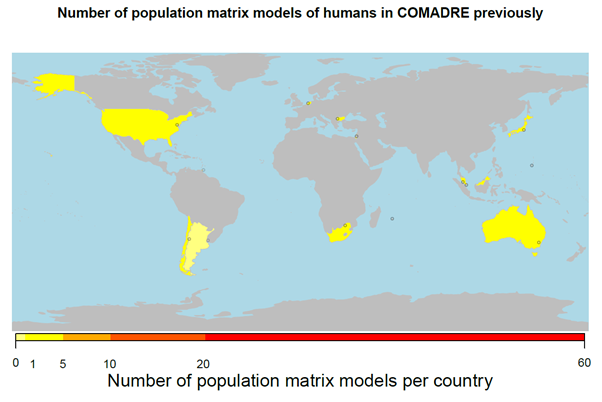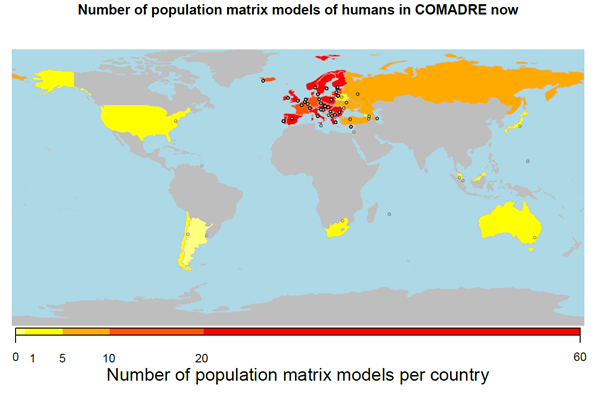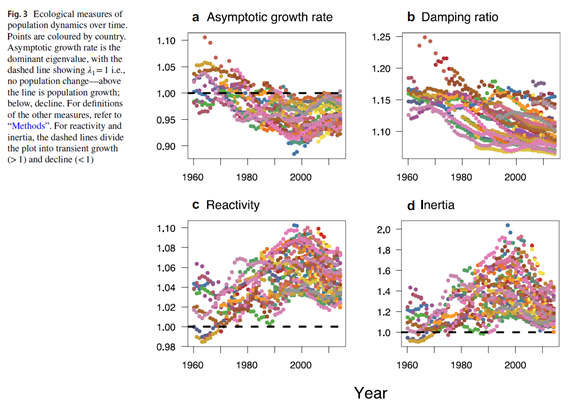Large human data addition to COMADRE
by Chelsea C. Thomas on Nov 7, 2020More than 1,100 human (Homo sapiens sapiens) matrices have been added to the COMADRE database with the incorporation of Nicol-Harper et al. (2018)! We thank Tom Ezard and Alex Nicol-Harper (University of Southampton) for facilitating this process. The following post is from Alex Nicol-Harper.
COMADRE contains population matrix models for a wide range of species, but until now had relatively few pertaining to a particularly widespread and important animal: Homo sapiens. Prior to the most recent update, the database held 26 human matrices, from 14 countries across 6 continents – not a bad geographical range, but temporally representing only 20 years from 1965. These matrices correspond to a subset of those presented in Keyfitz & Flieger’s (1990) atlas: ‘World Population Growth and Aging: Demographic Trends in the Late Twentieth Century’ – which, along with the two preceding volumes, has been fully digitised as part of a CPC project [http://pyramids.cpc.ac.uk/app/].

The new COMADRE update will include a further 1,120 human matrices, developed in our paper ‘Inferring transient dynamics of human populations from matrix non-normality’ [https://esj-journals.onlinelibrary.wiley.com/doi/pdf/10.1007/s10144-018-0620-y]. We used Eurostat [https://ec.europa.eu/eurostat/web/population/overview] data to add a further 40 European countries to the previously represented Bulgaria and Netherlands, and more than doubled the temporal range, with 6 countries each providing 55 consecutive years of data from 1960 to 2014. To correspond to Keyfitz & Flieger, we used female-specific data and aggregated into 5-year age bins, but went all the way to ’85 years and older’ as opposed to truncating after menopause. Countries with small populations (Andorra, Liechtenstein, San Marino) were excluded since many of their age groups regularly experienced zero deaths over 5 year periods.

The aim of our paper was to develop a measure of matrix susceptibility to transient dynamics: deviations from the asymptotic trajectory are triggered by unstable age structures, but do particular vital rate combinations enhance this effect? We showed that measures of matrix non-normality, a quantity used in linear algebra, correlate well with traditional indices of transient dynamics from the ecological literature. And those transient indices, when applied to the human populations of Europe, illustrate some interesting phenomena. They peak around the millennium, in contrast to asymptotic growth rates, which declined across the period and remained below 1 from circa 1995 (Fig. 3a). This provides evidence for a current ‘second demographic transition’ (van Daalen and Caswell 2015), with fertility dropping below the level required for replacement in the long-term. Nevertheless, applying these vital rates to the population structures found in Europe over this period almost always resulted in immediate population growth (reactivity >1; Fig. 3c) and boosts to asymptotic population size relative to stable population structure (inertia >1; Fig. 3d). Unstable age structures and variable vital rate regimes were likely due to changes across Europe during this time: not only the repercussions of demographic transition (Blue and Espenshade 2011), but as a result of political upheavals (such as the reunification of Germany in 1989 – see Goldstein & Kreyenfeld, 2010 – and the Yugoslavian conflict 1991-‘99) and ever-present migration (Espenshade and Tannen 2015, and the unpublished EU study therein).

While those explanations delve deep into human demography and socioeconomics, ultimately Homo sapiens is just another (particularly well-studied) animal. In that light:
“It remains to be seen how the three non-normality metrics perform across other systems and stage structures, and whether their interrelationships with population dynamic indices remain consistent. Comparative studies using the COMPADRE and COMADRE demographic databases (Salguero-Gómez et al. 2015, 2016) could prove particularly insightful here.” (p. 193)
Unfortunately, to (badly) paraphrase Game of Thrones, now our grant has ended. Could you apply our non-normality metrics to matrices from the COMADRE and COMPADRE databases? Please get in touch!
Blue, L. & Espenshade, T.J. (2011) Population momentum across the demographic transition. Population and Development Review, 37, 721–747.
Espenshade, T.J. & Tannen, J.B.C. (2015) Population dynamics: Momentum of population growth. In J.D. Wright (Ed.) International encyclopedia of the social and behavioural sciences, vol 18, 2nd edn. (pp. 572–578). Amsterdam, Netherlands: Elsevier.
Goldstein, J.R., & Kreyenfeld, M. (2010) East Germany Overtakes West Germany: Recent Trends in Order-Specific Fertility Dynamics. MPIDR WORKING PAPER WP 2010-033 NOVEMBER 2010 https://bit.ly/2GeBo5Q Accessed October 2020.
Keyfitz, N. & Flieger, W. (1990) World population growth and aging: demographic trends in the late twentieth century. Chicago, USA: University of Chicago Press.
Salguero-Gómez, R. et al. (2015) The compadre Plant Matrix Database: an open online repository for plant demography. Journal of Ecology 103:202–218
Salguero-Gómez, R. et al. (2016) COMADRE: a global data base of animal demography. Journal of Animal Ecology, 85, 371–384.
van Daalen, S. & Caswell, H. (2015) Lifetime reproduction and the second demographic transition: stochasticity and individual variation. Demographic Research, 33, 561–588


